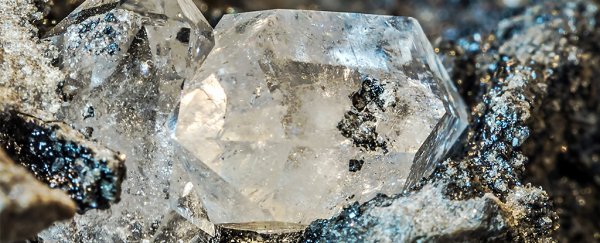Thanks to the discovery of water trapped inside diamonds from deep underground, geologists are thinking our planet could have much more water inside than we ever knew.
Not only would this require a slight recalculation of the total amount of water our planet happens to hold, it would change how we model everything from the way heat moves through the crust to models predicting the frequency of earthquakes.
Researchers made the find by analysing the way X-rays diffracted through diamonds collected from southern Africa, China, Zaire, and Sierra Leone.
The water molecules found in these diamonds were squeezed into a solid form of ice, but they represent briny pools of liquid water that would be trapped in rocks far, far down - below a section of the mantle called the transition zone.
While there have been previous estimates on how much water could be contained by the hot, pressurised rocks at those depths, the only way to be confident in any of the guesses is to acquire a sample.
Since we're talking more than 600 kilometres (roughly 400 miles) underground, you can forget digging down to grab a handful of magma.
Luckily there's a solution in nature's own tiny glass elevator – the diamond.
Only recently flecks of a mineral called calcium silicate perovskite (CaSiO3) were discovered inside a diamond. Despite the mineral's predicted prevalence in our planet's geology, it had never been seen - because it forms so far underground.
Similarly, the water molecules from below the transition zone were held under pressure inside flaws in the diamond crystal's matrix of carbon atoms.
Squeezing water molecules together forces them to arrange themselves into different structures, effectively turning them into forms of ice - and it's not like the simple stuff you can find in your freezer.
Different pressures can push the water molecules into a range of configurations, and this particular structure is called ice-VII. While it has been produced in the laboratory using containers pressurised to tens of thousands of atmospheres, this is the first time ice-VII has been shown to exist in the natural world, officially making it a bona fide mineral.
Based on the team's analysis of the diamonds, the water molecules must have become trapped as liquid when crystals formed around 610 to 800 kilometres (400 to 500 miles) beneath the surface.
Only as they ascended did the changing pressure push them into a form that allowed them to stick in place as ice-VII.
The good news is the inclusions provide the first hard evidence that unbound water exists at such depths, most likely as a salty fluid.
Unfortunately it doesn't say how much water there is inside such pockets, or how common these aqueous zones would be.
Knowing more about them would help inform our understanding of how soluble radioactive particles flow beneath the crust, which in turn would affect how we calculate the transfer of heat from the core to the surface.
Nailing down the distribution of water could also alter predictions on how sections of the crust sink beneath one another.
The mineral constitution of tectonic plates makes a significant difference to their density and the temperature at which they melt, factors that could help improve earthquake models.
Having confirmation that flowing water does indeed exist at these depths is a good start, and makes you wonder what other secrets might be lurking inside the world's favourite gem.
This research was published inside Science.
